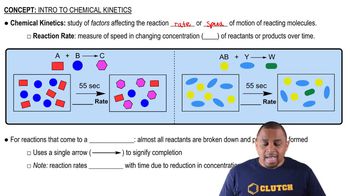Here are the essential concepts you must grasp in order to answer the question correctly.
Chemical Kinetics
Chemical kinetics is the study of the rates of chemical reactions and the factors that affect these rates. In this context, understanding how the concentration of NO2 changes over time is crucial for determining the time it takes for the concentration to drop from 0.0050 M to 0.0010 M. The rate of reaction can be influenced by temperature, concentration, and the presence of catalysts.
Recommended video:
Rate Law
The rate law expresses the relationship between the rate of a chemical reaction and the concentration of its reactants. For the decomposition of NO2, the rate law can be determined experimentally and is essential for calculating the time required for the concentration to decrease. It typically takes the form rate = k[NO2]^n, where k is the rate constant and n is the order of the reaction.
Recommended video:
Concentration and Molarity
Concentration refers to the amount of a substance in a given volume of solution, commonly expressed in molarity (M), which is moles of solute per liter of solution. In this problem, the initial concentration of NO2 is 0.0050 M, and the goal is to find the time it takes for this concentration to decrease to 0.0010 M. Understanding how to convert between moles and molarity is essential for solving the problem.
Recommended video:




